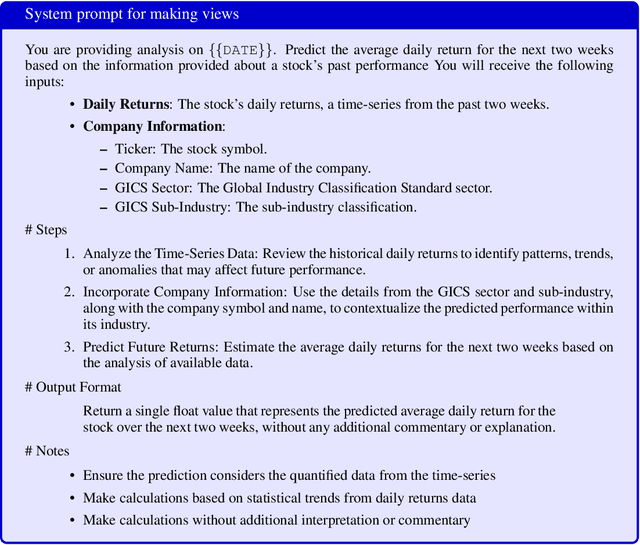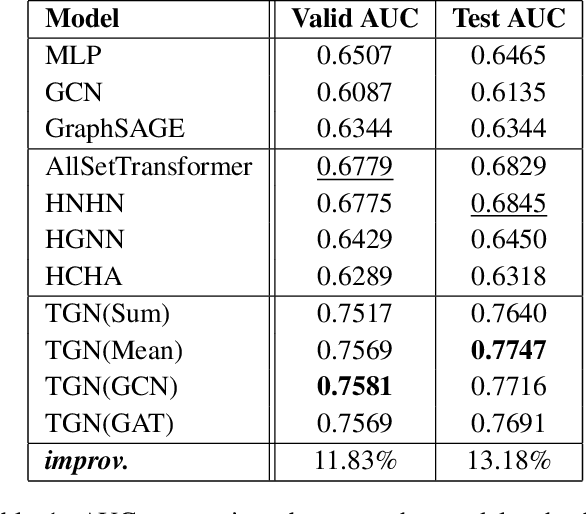Youngbin Lee
FinAI Data Assistant: LLM-based Financial Database Query Processing with the OpenAI Function Calling API
Oct 15, 2025



Abstract:We present FinAI Data Assistant, a practical approach for natural-language querying over financial databases that combines large language models (LLMs) with the OpenAI Function Calling API. Rather than synthesizing complete SQL via text-to-SQL, our system routes user requests to a small library of vetted, parameterized queries, trading generative flexibility for reliability, low latency, and cost efficiency. We empirically study three questions: (RQ1) whether LLMs alone can reliably recall or extrapolate time-dependent financial data without external retrieval; (RQ2) how well LLMs map company names to stock ticker symbols; and (RQ3) whether function calling outperforms text-to-SQL for end-to-end database query processing. Across controlled experiments on prices and fundamentals, LLM-only predictions exhibit non-negligible error and show look-ahead bias primarily for stock prices relative to model knowledge cutoffs. Ticker-mapping accuracy is near-perfect for NASDAQ-100 constituents and high for S\&P~500 firms. Finally, FinAI Data Assistant achieves lower latency and cost and higher reliability than a text-to-SQL baseline on our task suite. We discuss design trade-offs, limitations, and avenues for deployment.
GuruAgents: Emulating Wise Investors with Prompt-Guided LLM Agents
Oct 02, 2025Abstract:This study demonstrates that GuruAgents, prompt-guided AI agents, can systematically operationalize the strategies of legendary investment gurus. We develop five distinct GuruAgents, each designed to emulate an iconic investor, by encoding their distinct philosophies into LLM prompts that integrate financial tools and a deterministic reasoning pipeline. In a backtest on NASDAQ-100 constituents from Q4 2023 to Q2 2025, the GuruAgents exhibit unique behaviors driven by their prompted personas. The Buffett GuruAgent achieves the highest performance, delivering a 42.2\% CAGR that significantly outperforms benchmarks, while other agents show varied results. These findings confirm that prompt engineering can successfully translate the qualitative philosophies of investment gurus into reproducible, quantitative strategies, highlighting a novel direction for automated systematic investing. The source code and data are available at https://github.com/yejining99/GuruAgents.
* 7 Pages, 2 figures
Integrating LLM-Generated Views into Mean-Variance Optimization Using the Black-Litterman Model
Apr 19, 2025



Abstract:Portfolio optimization faces challenges due to the sensitivity in traditional mean-variance models. The Black-Litterman model mitigates this by integrating investor views, but defining these views remains difficult. This study explores the integration of large language models (LLMs) generated views into portfolio optimization using the Black-Litterman framework. Our method leverages LLMs to estimate expected stock returns from historical prices and company metadata, incorporating uncertainty through the variance in predictions. We conduct a backtest of the LLM-optimized portfolios from June 2024 to February 2025, rebalancing biweekly using the previous two weeks of price data. As baselines, we compare against the S&P 500, an equal-weighted portfolio, and a traditional mean-variance optimized portfolio constructed using the same set of stocks. Empirical results suggest that different LLMs exhibit varying levels of predictive optimism and confidence stability, which impact portfolio performance. The source code and data are available at https://github.com/youngandbin/LLM-MVO-BLM.
A Recommender System for NFT Collectibles with Item Feature
Apr 03, 2024


Abstract:Recommender systems have been actively studied and applied in various domains to deal with information overload. Although there are numerous studies on recommender systems for movies, music, and e-commerce, comparatively less attention has been paid to the recommender system for NFTs despite the continuous growth of the NFT market. This paper presents a recommender system for NFTs that utilizes a variety of data sources, from NFT transaction records to external item features, to generate precise recommendations that cater to individual preferences. We develop a data-efficient graph-based recommender system to efficiently capture the complex relationship between each item and users and generate node(item) embeddings which incorporate both node feature information and graph structure. Furthermore, we exploit inputs beyond user-item interactions, such as image feature, text feature, and price feature. Numerical experiments verify the performance of the graph-based recommender system improves significantly after utilizing all types of item features as side information, thereby outperforming all other baselines.
Temporal Graph Networks for Graph Anomaly Detection in Financial Networks
Mar 27, 2024


Abstract:This paper explores the utilization of Temporal Graph Networks (TGN) for financial anomaly detection, a pressing need in the era of fintech and digitized financial transactions. We present a comprehensive framework that leverages TGN, capable of capturing dynamic changes in edges within financial networks, for fraud detection. Our study compares TGN's performance against static Graph Neural Network (GNN) baselines, as well as cutting-edge hypergraph neural network baselines using DGraph dataset for a realistic financial context. Our results demonstrate that TGN significantly outperforms other models in terms of AUC metrics. This superior performance underlines TGN's potential as an effective tool for detecting financial fraud, showcasing its ability to adapt to the dynamic and complex nature of modern financial systems. We also experimented with various graph embedding modules within the TGN framework and compared the effectiveness of each module. In conclusion, we demonstrated that, even with variations within TGN, it is possible to achieve good performance in the anomaly detection task.
A Temporal Graph Network Framework for Dynamic Recommendation
Mar 24, 2024


Abstract:Recommender systems, crucial for user engagement on platforms like e-commerce and streaming services, often lag behind users' evolving preferences due to static data reliance. After Temporal Graph Networks (TGNs) were proposed, various studies have shown that TGN can significantly improve situations where the features of nodes and edges dynamically change over time. However, despite its promising capabilities, it has not been directly applied in recommender systems to date. Our study bridges this gap by directly implementing Temporal Graph Networks (TGN) in recommender systems, a first in this field. Using real-world datasets and a range of graph and history embedding methods, we show TGN's adaptability, confirming its effectiveness in dynamic recommendation scenarios.
NFTs to MARS: Multi-Attention Recommender System for NFTs
Jun 13, 2023Abstract:Recommender systems have become essential tools for enhancing user experiences across various domains. While extensive research has been conducted on recommender systems for movies, music, and e-commerce, the rapidly growing and economically significant Non-Fungible Token (NFT) market remains underexplored. The unique characteristics and increasing prominence of the NFT market highlight the importance of developing tailored recommender systems to cater to its specific needs and unlock its full potential. In this paper, we examine the distinctive characteristics of NFTs and propose the first recommender system specifically designed to address NFT market challenges. In specific, we develop a Multi-Attention Recommender System for NFTs (NFT-MARS) with three key characteristics: (1) graph attention to handle sparse user-item interactions, (2) multi-modal attention to incorporate feature preference of users, and (3) multi-task learning to consider the dual nature of NFTs as both artwork and financial assets. We demonstrate the effectiveness of NFT-MARS compared to various baseline models using the actual transaction data of NFTs collected directly from blockchain for four of the most popular NFT collections. The source code and data are available at https://anonymous.4open.science/r/RecSys2023-93ED.
 Add to Chrome
Add to Chrome Add to Firefox
Add to Firefox Add to Edge
Add to Edge